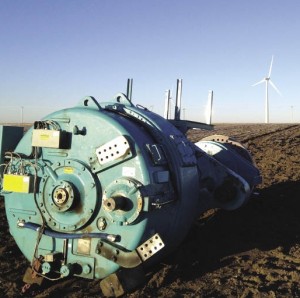It’s not often that a technical conference leaves attendees with an ah-ha moment, but it happened at the recent Gearbox Reliability Collaborative sponsored by NREL at its offices in Golden, Colo. All presentations were good, but two in particular answered interesting questions raised by the other. Here’s what I mean:
A presentation by Aaron Greco from the Tribology Section at Argonne National Lab (anl.gov) showed images of damaged bearing material from an optical microscope and a scanning electron microscope. Greco and his team cut damaged bearing elements and races apart to expose cross sections of material. When the sections were etched to highlight the material, an unexplained phenomena, called white area etching, presented itself in most every case. Greco says the white etching is not a flaw but white microstructure, a sort of side effect of the failure. What’s more, the bearing material had changed in the damage areas. Clean steel on undamaged bearings shows no such characteristics.
Bob Errichello with GEARTECH provided more detail with scanning electron images that showed damage starting about 200 µm below the surface. Why at those locations or that depth is a bit of a mystery, but Errichello suggests they may be locations of high residual manufacturing stress that become over stressed by impact loading. “With the impact, the flaw then pops to the surface,” he says. There are other failure causes. One theory, for instance, points a finger at hydrogen embrittlement caused by worn oil.

The gearbox probably failed before four years of service. It now waits at a wind farm for shipment to a factory for repairs.
Then Errichello added, “Although I don’t know with certainty the origin of the flaws, I know a solution to the failure problem.” The material in wind turbine bearings, he says, is too hard and therefore brittle. He suggests using bearings of less hard carburized steel rather than through-hardened steel.
But where do the impact loads come from? An answer to that came a few presentations later when Dave Heidenreich and Doug Herr with PT Tech (pttech.com) presented torque plots taken from the main shaft of a turbine during shutdowns in high winds. Their graphs showed torques going from positive to negative several times as the shaft speed slowed. Heidenreich explained that during torque reversals the unloaded segment of rolling elements in the bearings are suddenly loaded and then unloaded as the torque bounces from positive to negative. That provides the impact loads. He further suggested that emergency stops would generate greater reversing torque loads.
Once bearings begin to fail, gears loose alignment, load areas on gear teeth shrink, and stress concentrates rise, and that generates rapid wear and eventual tooth failure. Heidenreich says he’s looking for a volunteer turbine onto which he’ll put his strain gages and measure torque loads during E-stops.
What may be more important, he provided a way to control the reversing torque load with mechanical limiter. It allows setting different torque limits in the positive and negative directions. This will keep torque negative on a stopping turbine and prevent impacts to gearbox bearings. The working life of a gearbox could be lengthened, Heidenreich estimates, to about 10 years.
And that feat would be a great boon to the wind industry. The PTC will likely go away in 2014, but costly gearbox failures will not.
–PaulDvorak
Filed Under: News






The article is right on target. Microstructure and specific CC HT is the right solution to solve WEC. We have seen some case hardened bearings fail but it’s because the manufacturer still didn’t have the right case hardened recipe. Others can push black oxide (surface rust), but it’s only a temporary band-aid that provides little benefit during the run-in process.
Very interesting. These findings should eventually eliminate direct drive for industrial wind turbines above 1 MW.
However, case carburized bearings fail too (eventually less)! Furthermore, the bearings need to be completely gone before there will be misalignment in the gears.
We know that black oxidized bearings perform well.